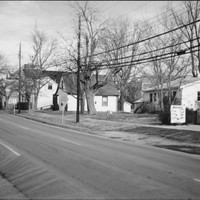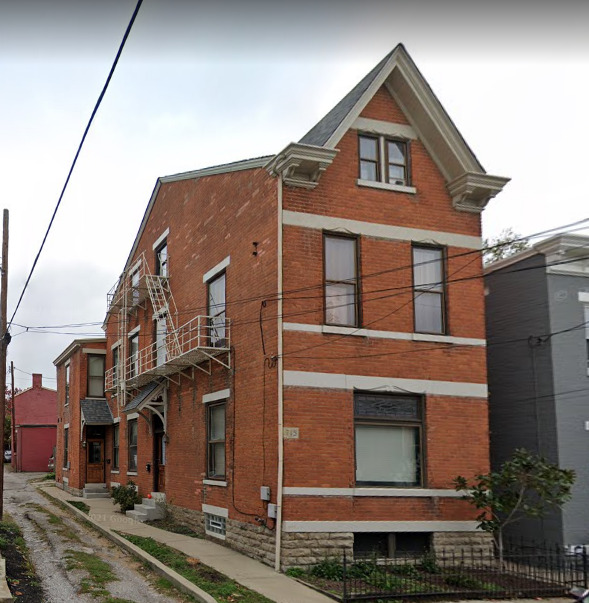-
Title
-
1876--Smith Williams Taken from Jail and Lynched
-
Date
-
Jun 1876
-
Formatted date
-
1876-06-01
-
Event type
-
Lynching
-
Description
-
Little is known about the early life of Smith Williams. He was born somewhere in Kentucky around 1843 and in 1870 Williams was living with his wife, Melinda, and their ten-month-old daughter, Kate, in Covington. According to the census record of that year, Smith Williams worked as a general laborer. Like many African Americans in the region, he may have come to town in search of work to support himself and his family after the Civil War. In 1871, Smith Williams appeared in the Covington, KY City Directory, listed again as a laborer. He was living at 715 Willard Street, between Seventh and Eighth streets, not far from Covington’s Main Strasse neighborhood. It’s likely he rented an apartment for his family in the multi-family building (see image).
Smith and his family moved to Boone County soon after, where his name appears on the county tax lists from 1872-1874. On July 1, 1875, Smith was working on a farm in the village of Constance, not far from the Anderson Ferry on the Ohio River. A group of hunters were crossing the property where he worked and Williams fired upon them with his rifle. One man was wounded; a young white man named Frederick Wahl, who lived in Constance with his parents and siblings. There was speculation that Williams fired upon Wahl for trespassing, though it’s not clear what provoked the action. Wahl died of his wounds within a few days and Williams fled the area, fearing for his own life.
In early March, 1876, brothers Eph and Montgomery Anderson, Constance residents, arrived in Indianapolis. They had received word that Smith Williams was living there under the alias “Enos Thompson” and they had come seeking justice for Fred Wahl’s death. The men summoned local authorities who went to make the arrest. As an officer arrived to capture Williams, he put up a great struggle, but was ultimately apprehended and returned to the Burlington Jail to await arraignment, his bond set at $1000
Williams expressed the very rational fear of being forcibly taken from his cell by a mob of vigilantes to Samuel Cowan, the county jailer. There had never been a lynching in Boone County at that time, so it’s possible the jailer believed all was secure and the rule of law would prevail. Smith languished in his cell for weeks awaiting trial, kept company by several other prisoners. Late in the third week of June, 1876, the last remaining prisoner was released, leaving Williams alone and vulnerable.
Samuel Cowan lived just across the road from the small jail; but it’s likely that Williams was alone in the building on the night of June 22nd when a large, angry mob arrived at about 1 AM. Several of the group roused the jailer, claiming to have a prisoner that needed to be locked up. As Cowan emerged from his home, keys in hand, he was accosted, a hand placed over his mouth and the keys forcibly taken from him.
When the men reached Williams’ cell door, the prisoner began to scream “Fire! Murder!” and hollered for the jailer, Cowan, who was being held by some of the mob, unable to come to his aid. Williams broke away and got as far as the southwest corner of the courthouse before he was overtaken. Men were shouting and shooting their pistols in the air as the scene intensified. The commotion was loud enough for Melinda Williams to hear from the home where she worked and lived with their young daughter Katie, just about a block away.
As the angry mob caught up with Williams, he was struck in the head with a hammer of the style used for cutting iron. The hammer, later found near the scene, was stamped with “I. & C.R.R.” indicating it was the property of the Indianapolis and Cincinnati Railroad Company. Smith was badly wounded and it was later determined that, among the many injuries to his body, he had several large gashes in his head and a fractured skull, doubtless from the blows of the hammer.
The mob’s intent was to hang Smith Williams where they first detained him, within view of the courtroom where he was to be tried by law for the charge against him. Calls for a rope by the mob went unanswered, so they took their victim, loaded him in a wagon and headed off in the direction of Florence to complete their dark goal. The shouts of the mob, mingled with sounds of gunshots and Smith’s agonized cries began to fade into the distance as a frantic Melinda Williams came running to the scene from the home of her employer, within earshot of the courthouse square. The sight of her husband being hauled away to his death was her last glimpse of him alive.
The following morning, travelers down Burlington Pike were greeted by the horrific sight of the body of Smith Williams, hanging from a walnut tree, his hands and feet bound. An inquest was held and the body was examined. The foreman of the jury summoned to the scene was none other than Noah Craven, whose farm was the likely site of the lynching.
Smith Williams’ body was washed, dressed and interred in the Pauper’s cemetery. Sometime in the years after the loss of her husband, Melinda remarried. She and Kate, the daughter she shared with Smith Williams, appear in the 1880 census with her second husband, Walker Gaines. None of the members of the lynch mob were ever identified.
-
Participant
-
African American(s): Smith Williams
-
Other participant(s): Melinda Williams; Fred Wahl
 Burlington (Ky.)
Burlington (Ky.)
 715 Willard Street.png
715 Willard Street.png